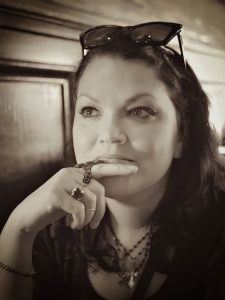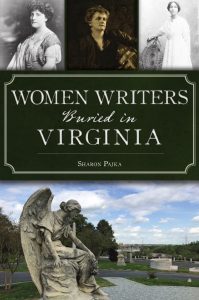Reading the Dead: Women Writers buried in Virginia Cemeteries
 During the summer of 2020 when the COVID-19 pandemic suspended cemetery tours and gatherings, I looked for another way to feel connected with history. As an English professor, I naturally found myself reading the works of the authors buried in my local cemeteries including Ellen Glasgow, who won the Pulitzer Prize in 1942, and popular novelist Mary Johnson, who also was a suffragist and the first woman to top the best-seller lists in the twentieth century. After reading their writing, I felt a stronger connection to these women while standing at their graves.
During the summer of 2020 when the COVID-19 pandemic suspended cemetery tours and gatherings, I looked for another way to feel connected with history. As an English professor, I naturally found myself reading the works of the authors buried in my local cemeteries including Ellen Glasgow, who won the Pulitzer Prize in 1942, and popular novelist Mary Johnson, who also was a suffragist and the first woman to top the best-seller lists in the twentieth century. After reading their writing, I felt a stronger connection to these women while standing at their graves.
As a volunteer cemetery tour guide without any tours planned, on a summer day in July, after not leaving the house for four months due to the pandemic, I set out to go see the grave of contemporary Gothic novelist, VC Andrews. It was a hot, sunny day but I felt refreshed and energized. On the back of Andrews’ grave is an epitaph that begins, “Books opened doors I hadn’t even realized were there.” After an ominous start to the year, I felt safe. I remembered how much I loved Susan Wilson’s book, Literary Trail of Greater Boston (2000) and it was at the grave of VC Andrews that I decided to expand my initial research in local cemeteries and make a series of road trips to visit women writers’ graves across Virginia. I wanted to take myself on a grand tour of women writers. I just had to find them first!
As a collector of cemetery maps, I began my research by noting the women mentioned within these brochures and on cemetery websites that listed notable interments. Unsurprisingly, cemetery brochures and website notable lists are heavily focused on military heroes, founding fathers, political leaders and the who’s who in the region’s history. Each time I discovered a new cemetery brochure, I found myself quickly scanning to find the famous or infamous females who helped build a region’s history. More often than not, from the dozens of entries, there are usually only a few women mentioned, rendering the majority of women invisible.
My initial research was not systematic or structured; it was merely a way for me to get out of the house and enjoy some socially-distanced connections to history. I have always loved cemeteries. As I am a grandchild of a genealogist, some of my earliest and best memories included helping my grandfather look for family members in old cemeteries. While I was physically distant from others during each visit, I was not alone. Numerous cemeteries across the nation reported an increase in visitors while indoor attractions closed to help slow the spread of the virus. Individuals and families were encouraged to seek recreation outdoors, and while small public parks became crowded and regional museums closed their doors, historic garden cemeteries with acreage to spare regained visitor attention.
To find women writers buried in Virginia cemeteries, I first needed to find out who the women writers were. Texts such as Mary Tardy’s 1872 The Living Female Writers of the South started part of my journey, at least discovering women from a specific time period. I discovered nearly a dozen women in Tardy’s text. One of the struggles with her text and other similar resources is if a women writer was married, she was referenced by Mrs. (husband’s name). I spent hours on Ancestry.com and Newspapers.com just making associations between writers. And then there were pen names. Women writers did not always use their real names for various reasons.
Even websites such as Find A Grave did not help with labeling. Society pages in newspapers turned out to be one of my best and favorite sources. Although one entry in a society page cannot tell a story, if a researcher tracks enough entries, she can start to build someone’s life story and discover with whom the writer visited, including other women writers and where the writer traveled, which also helped me find where these women may have ended up in United States Census reports. And while rare, some grave markers include some kind of indication of an occupation or identity as a writer. Occupations can define who we feel we are so it is logical that someone would end up marking their gravestone with their occupation.
 Each time I found a grave-marker with the inscription of “author,” “authoress,” or “poet,” I was delighted. In the case of my research, only eight women writers have any sort of indication that they were once a writer. The earliest grave-marker with her occupation listed is novelist and poet, Susan Archer Talley Weiss who died in 1917. The latest burial includes poet and children’s book author, Ruby Altizer Roberts whose grave includes a plaque with a notation that she was the first woman to be named poet laureate of Virginia.
Each time I found a grave-marker with the inscription of “author,” “authoress,” or “poet,” I was delighted. In the case of my research, only eight women writers have any sort of indication that they were once a writer. The earliest grave-marker with her occupation listed is novelist and poet, Susan Archer Talley Weiss who died in 1917. The latest burial includes poet and children’s book author, Ruby Altizer Roberts whose grave includes a plaque with a notation that she was the first woman to be named poet laureate of Virginia.
Visiting Virginia cemeteries became my respite. I visited each writer’s grave as a way to connect with history by physically being there, and I read some of each of their writing. On November 15, 2021, my research came to fruition with my book Women Writers Buried in Virginia being published by The History Press. The book includes a collection of forty-four women writers who were widely popular during their lifetimes, those who still show up in college anthologies, and those whose works were made into popular movies. This is not an exhaustive list; I continue to find women writers, and I will continue to search for them. I encourage readers to visit the graves of these writers and to search for women writers in their local cemeteries. A wealth of history can be found standing in the locations where these women were buried.
—
Bio:
Sharon Pajka, PhD, is a professor of English at Gallaudet University. On the weekends, find her in the cemetery giving history tours or volunteering, as well as running River City Cemetarians.
- Book: Women Writers Buried in Virginia (2021)
- Blog: Goth Gardening: https://goth-gardening.
blogspot.com/ - Facebook page for River City Cemetarians: https://www.facebook.com/
RiverCityCemetarians
Category: On Writing

























